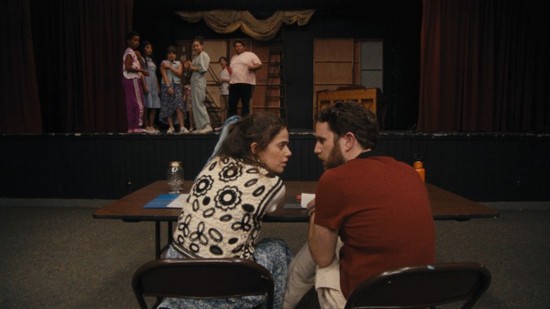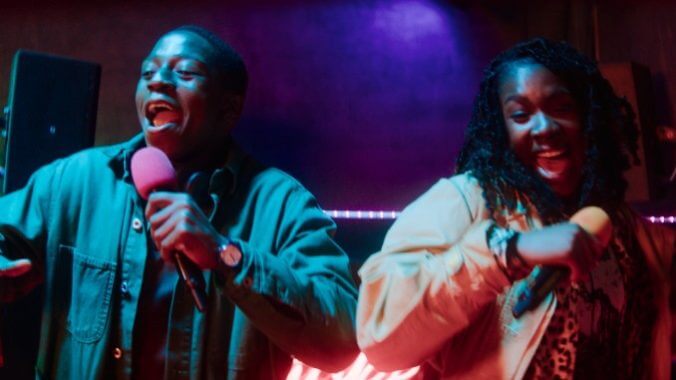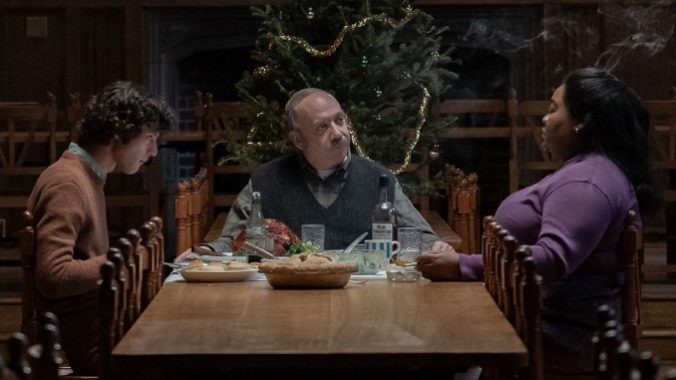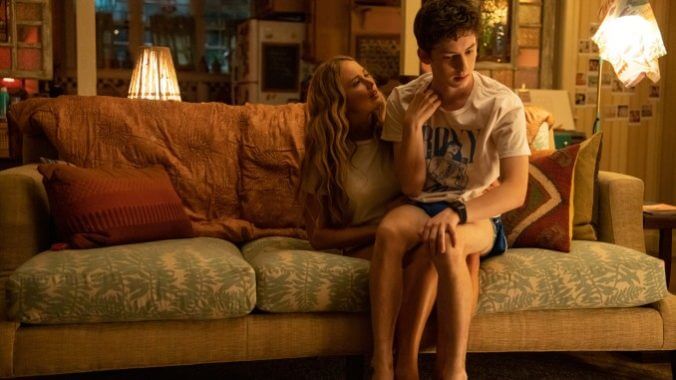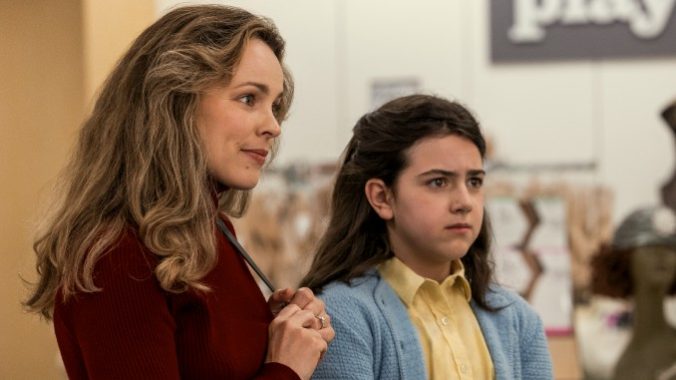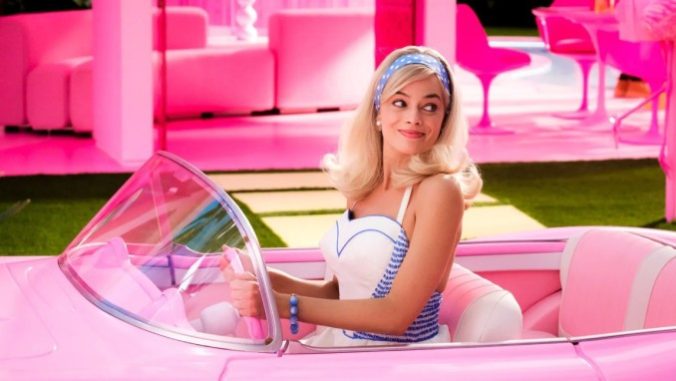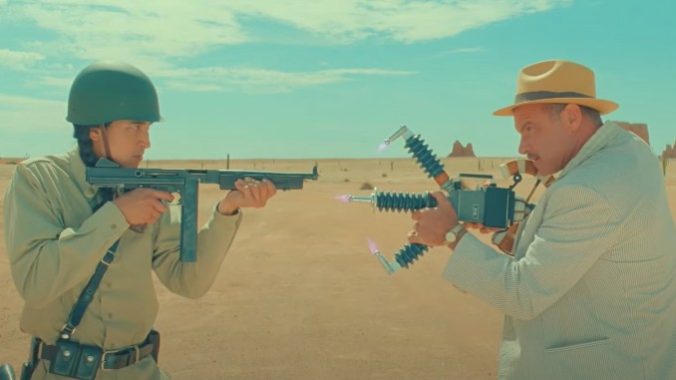The 20 Best Comedies of 2023
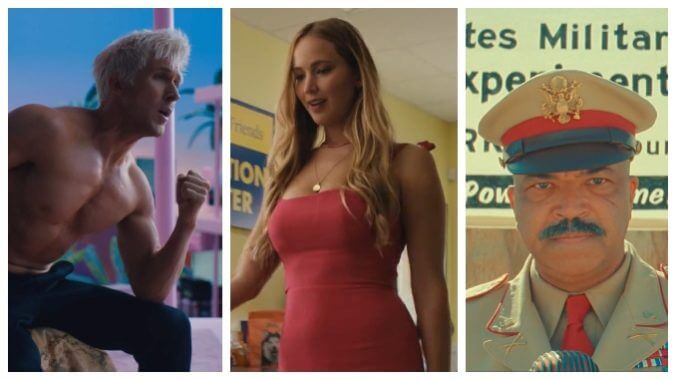
The best comedies of 2023 were, like they so often are, hiding inside of other genres. We can’t have horny neo-Frankensteins, killer dolls, drug-dealing clones, wedding martial artistry, psychosexual mindgames, or even the sale of BlackBerries without injecting some of the best laugh-out-loud lines of the year. Some of this seemingly strange situation is due to a clear problem: There just aren’t that many straightforward comedies getting made these days. Some of it is that the action/superhero blockbuster has gotten so quippy as a form that it’s leaked out into some of those vying for box office dollars. And some of it is simply because silliness is back on the rise, in all corners. That’s a win. The best comedies of 2023 encompassed wry indies, full-frontally bawdy studio films, animated hybrids featuring giggling ninja turtles, and Ken. He is kenough for Barbie, and he’s kenough for this list. These movies tackle queerness, coming-of-age and, again, a surprising amount of business transactions. We’ve all decided, collectively, that capitalism is ludicrous, so we might as well point and laugh! Enjoy these movies from Wes Anderson, Alexander Payne, Nicole Holofcener, Raine Allen-Miller, Juel Taylor, Nida Manzoor, Yorgos Lanthimos and many, many more — with a year this dire, we all need a chuckle.
Here are the 20 best comedies of 2023:
20. You Hurt My Feelings

Beth (Julia Louis-Dreyfus) accidentally overhears her therapist husband Don (Tobias Menzies) offering an honest and negative assessment of her in-progress novel, after receiving many drafts’ worth of encouragement from him. This premise (or something like it) has probably been used on at least three sitcoms; even here, it features one of the form’s great performers in Louis-Dreyfus. But You Hurt My Feelings is also written and directed by Nicole Holofcener, an expert in revealing the invisible tensions lurking behind social and relationship niceties. Her latest film is very funny; even more impressive, it spins what could have been 22 minutes’ worth of misunderstanding and lesson-learning into genuine searching; turns out Tobias is nursing some professional insecurity, too, and not without cause. So are we actually as good at our jobs (and passions!) as we imagine, or are we all just insecure incompetents coasting on the mindless, dishonest praise of our loved ones? The answer probably lies somewhere in between, but Holofcener is clear-eyed enough to give the latter a surprisingly full consideration.—Jesse Hassenger
19. Dumb Money
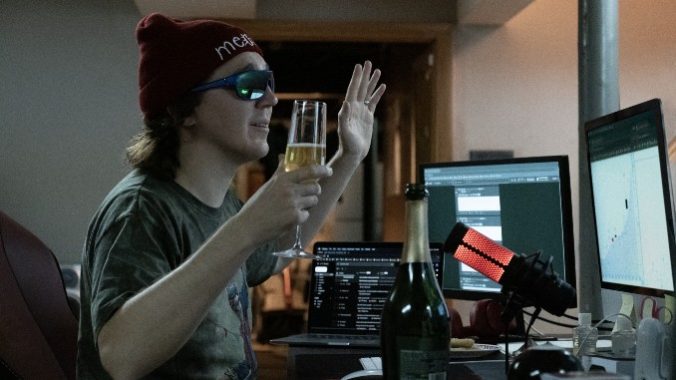
Based on the true events around the GameStop short squeeze mania that inspired author Ben Mezrich’s 2021 book The Antisocial Network, Dumb Money focuses on the 2021 stock market hullabaloo instigated by the internet Pied Piper influencer, Keith Patrick Gill (Paul Dano). An average middle-class husband and father in Brockton, Massachusetts, Gill spent a lot of his free time either running at the local high school track, or in his basement researching potential stocks to invest his relatively small personal savings into. As an accounting nerd, he shared his findings publicly under the handles u/DeepFuckingValue on Reddit and Roaring Kitty on Twitter and YouTube. Things got interesting when he got fixated on the potential of GameStop stock mostly for how it was being ignored by stockbrokers and hedge funds. In 2020, he eventually bought $50,000 shares and built a community of like-minded, everyday followers who agreed with his methodology and his very simple ethos: “I like the stock.” Using lessons learned from The Big Short, Gillespie’s Dumb Money is even more accessible because screenwriters Lauren Schuker Blum and Rebecca Angelo broaden the circle of impact to include people from all walks of life. The ensemble is also extremely well cast with comedians and character actors who are adept in conveying a lot of heavy stock market exposition in grounded, witty and absorbing ways. Pete Davidson in particular is a welcome idiot as Keith’s burnout brother, Kev, who both gleefully busts on and supports his brother’s internet fame. Dumb Money makes a strong anti-capitalist case, as the fight for GameStop’s stock becomes an existential war meant to prove the system is broken for everyone but the ultra-rich. And Dumb Money makes it clear that this applies not just to the stock market but to the pandemic too, as every frontline worker had to follow the rules and stay on the job, while the rich bent the rules to make money at their expense. What Dumb Money does very well is show that the GameStop stock story is more than just a meme for our times, but a first stone in the pond with a ripple effect that’s still a work in progress.—Tara Bennett
18. Leo
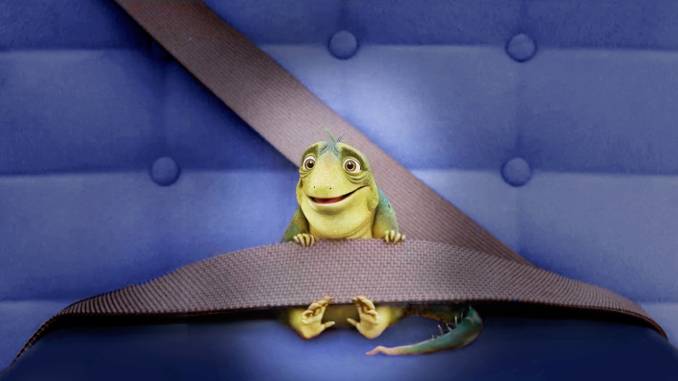
My two kids (ages 13 and 11) and I didn’t expect much from Leo the lizard (Adam Sandler), a class pet, and the friendship that evolves between the reptile and the Florida students in their final year of elementary school. But we were pleasantly surprised; my kids were in stitches at several spots, while I was quite amused. Leo proved to be a perfect, lighthearted watch on a rainy evening that left us with a feeling of bonhomie before switching off the lights for the night. Will it help my children discover the comedic antics of the former SNL star? Unlikely. But now they might not have quite the same bored face when I pull up a clip of Sandler singing “The Chanukah Song,” especially when I tell them it’s the same guy who sang a pretty grim lullaby as Leo. Part of Leo’s charm lies in the story. Leo is 74 years old, and has shared the same glass tank with Squirtle the Turtle (Bill Burr) for more than seven decades. When Leo learns that he may only have another year to live, he wants to make a mad dash for the Everglades and catch the sunsets in the wild before his own final sunset. An opportunity presents itself when the mean substitute teacher Mrs. Malkin (Cecily Strong) forces the students to take one of the pets home for the weekend. Summer (Sunny Sandler), the class keener who can bore everyone into facial paralysis with her neverending spiels, gets the first assignment. While making his escape, Leo accidentally lets slip that he can talk. And it turns out that he’s a good listener too. Years of watching the kids go in and out of the classroom makes him a de facto therapist, and he dispenses his wisdom generously, often in nonsensical songs. Given the simplicity of the story, most of Leo’s appeal comes from its comic observations. Take, for example, Leo and Squirtle discussing the new batch of kids introduced at the beginning of the year. The montage is full of wisecracks you might expect at an elementary school stand-up. Leo’s animation is fine; no fancy tricks on the CGI front. Its songs are not schmaltzy, and as such are unlikely to become annoying anthems such as “Let It Go.” If you’re looking for a general mood lifter, and something easy to watch, Leo is a great option.–Aparita Bhandari
17. Bottoms
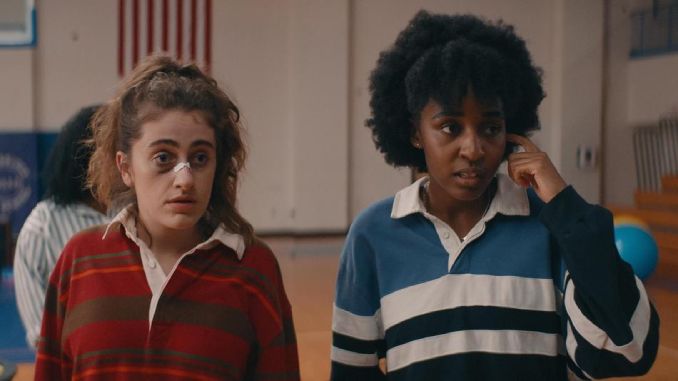
Every now and then, a comedy rolls around that is delightfully unafraid of utter ridiculousness—of pushing buttons and boundaries until it’s blue in the face. Directed by Emma Seligman (Shiva Baby) in her sophomore feature, Bottoms is such a comedy. The film follows P.J. (Rachel Sennott) and Josie (Ayo Edebiri), two wildly unpopular gay high schoolers who found a female fight club to impress their cheerleader crushes: Brittany (Kaia Gerber) and Isabel (Havana Rose Liu), respectively. This is a premise that naturally lends itself to a healthy dosage of humor, but Seligman doesn’t dare rely too heavily on her high-concept conceit. With the help of Sennott, who co-wrote the script, Seligman squeezes every ounce of humor out of each of the film’s thoughtfully-crafted scenarios—for better or worse. More often than not, this yields either shockingly bloody and hilarious visual gags, such as an impeccably-timed explosion or punch to the face, or masterfully-delivered punchlines about I-can’t-believe-she-went-there topics like bombs or abortions. In the rare moments that Bottoms takes a turn into sincerity, the dialogue is subtle yet acutely affecting, and indicates that its writers have a heartfelt understanding of what their characters are going through. If they had just sacrificed a couple of visual gags and attached their film a little more tightly to reality, Bottoms would be both poignant and laugh-out-loud funny. In her defense, it does make sense why Seligman wasn’t interested in giving up any of the film’s punchlines. She did, after all, hit the jackpot with one of the funniest ensemble casts of the past decade. The chemistry between the two leads is exquisite, which shouldn’t come as a surprise; the two previously spearheaded the uproarious Comedy Central web series Ayo and Rachel Are Single. When Seligman’s short film Shiva Baby premiered at South by Southwest back in 2018, audiences widely recognized the budding director as someone with a unique talent for whipping up a tight, sharp comedy in a small space. Now that her budget and scope are bigger, she has once again proven that she has an outstanding command over the genre.—Aurora Amidon
16. They Cloned Tyrone
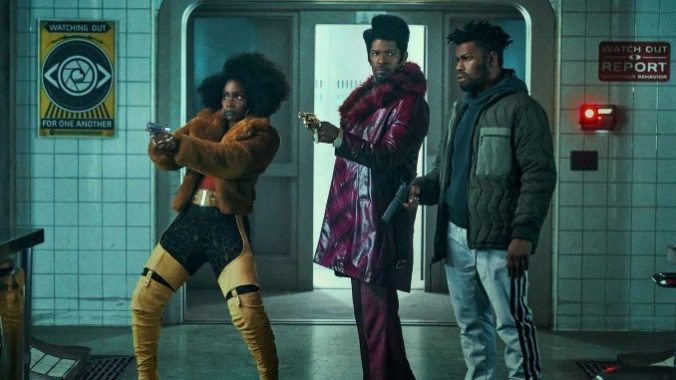
There are period films that revel in accumulating accurate and/or eye-catching details of production design and costumes to evoke a particular era, and science fiction films that world-build with all of the imagination their budget can afford (though maybe not as many of those as we’d like). Juel Taylor’s They Cloned Tyrone occupies a fascinating middle ground between the two: A more-or-less contemporary movie that looks like a period piece, and a sci-fi picture that stashes its wildest elements underground, sometimes literally. It has a tinge of Blaxploitation that stops shy of parody – a visual sense underlining the way that urban neighborhoods can be left behind as time marches on, lending them a sense of both neglect and integrity. The movie starts out following Fontaine (John Boyega), a drug dealer in an enclave of an unnamed city, referred to only as the Glen. Mostly, his workday entails collecting debts, as well as light maiming – at one point, he hits another dealer with his car. Despite this attack, Fontaine doesn’t seem like he’s itching to resort to violence; while hitting up local pimp Slick Charles (Jamie Foxx) for some money, he’s appropriately threatening but not ice cold. He’d rather just get his money and keep on grinding. Just after his visit to Slick Charles, there’s evidence that this head-down, money-first approach is preferable, as Fontaine’s earlier foray into vengeance comes back around, and the wounded dealer and his flunkies shoot Fontaine dead. Or so it seems. He awakes with a start, back in his home, and proceeds through the same routine we’ve already seen: Checking on his mom, swinging by the liquor store, collecting debts. Slick Charles and one of “his” girls, the perpetually dissatisfied Yo-Yo (Teyonah Parris), are particularly surprised to see him, because they’re pretty sure they saw him die. This unlikely trio – the taciturn Fontaine, the goofier and citrus-obsessed Slick Charles, and the Nancy Drew-inspired Yo-Yo – team up for an impromptu investigation, as Fontaine realizes he didn’t just have a particularly strange and vivid dream. On a scene-by-scene basis, They Cloned Tyrone is well-crafted entertainment, buoyed by its three major performances. Boyega affects a stoic movie-star minimalism in the tradition of Clint Eastwood or the more restrained performances of Tommy Lee Jones, making his brief moments of levity all the more effective. Foxx, outfitted in stereotypical pimp gear, makes a potentially doofus-y (or even, depending on the context, kind of vile) character likable in his oddly chipper demeanor and oddball references. (In general, the movie’s pop-culture references are just about perfect: Not obscure for obscurity’s sake, but left-of-center enough for genuine novelty.) And Parris in particular feels like a revelation, a firecracker amateur detective who knows her way around funny banter. Taylor and his co-writer Tony Rettenmaier make some smart implications about cultural assimilation and, eventually, the process of opting in to your own exploitation. What sets the movie apart from so many post-Get Out sociological thrillers, though, is the cleverness and style of the path Taylor lays out for his endearing characters. —Jesse Hassenger
15. Dream Scenario

Norwegian-born, L.A.-based director Kristoffer Borgli has built his filmmaking career satirizing the way brands capitalize on the narcissistic impulses of young people. DRIB (2017) told the story of Borgli’s real life friend Amir, an absurdist performance artist who nearly scammed his way into becoming the face of a major energy drink. Borgli broke out earlier this year with Sick of Myself, a black comedy about a young woman so desperate for brand attention that she makes herself deathly ill. Dream Scenario marks Borgli’s first full English-language film, as well as his most ambitious film to date, in terms of budget, content and genre. Borgli has expanded past straightforward black comedy and into surrealist horror-comedy. Not only are narcissism and corporate shallowness in Borgli’s crosshairs, but he has also added “cancel culture” to the list. Nicolas Cage stars as Paul Matthews, a balding, tenured university biology professor so unremarkable that it’s almost impressive. His younger daughter Sophie (Lily Bird) has a strange dream where mysterious objects fall from the sky, she begins to levitate and her father just stands there, watching. Inexplicably, everyone around him, including his students and even strangers, starts having a similar version of Sophie’s dream; some kind of disaster is taking place, and Paul stands there, doing nothing. Since this is a Borgli picture, where there’s viral fame, there’s a brand deal. Unlike Borgli’s previous films, Dream Scenario is less about the art of the brand deal, and more about the swift loss of the brand deal, once Paul’s “dream scenario” shifts from a bizarre, but ultimately harmless phenomenon to a terrifying nightmare. Soon, Paul isn’t just a passive bystander in people’s dreams—he’s the perpetrator of unspeakable violence in their nightmares. Thanks to Mandy cinematographer Benjamin Loeb’s harrowing photography in the nightmare sequences, the idea that Paul could be plausibly “canceled” is successful. Less singular in its vision than Sick of Myself, Dream Scenario may be a hilariously scary ride, but by the final 30 minutes, Borgli has lost sight of his original aims. Yes, taking cheap shots at influencers is amusing, but it’s not as original as it may have been a few years ago, and it’s not worth derailing the entire plot for. That said, the bittersweet last frame of Dream Scenario brings to mind Charlie Kaufman’s acerbic writing and Michel Gondry’s darkly whimsical direction on Eternal Sunshine of the Spotless Mind: A man enters his lover’s dream with the aim of winning her back.—Katarina Docalovich
14. M3GAN
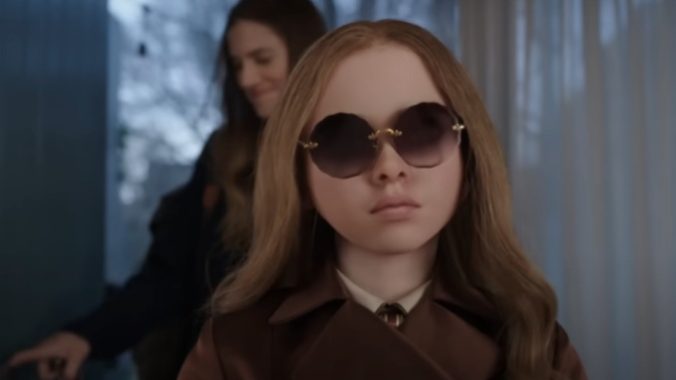
Long before M3GAN hit theaters, the film’s titular cyborg, who can best be described as a mashup of Renesmee from Twilight (if she was a raging sadist) and a yassified Baby Annette, became a viral sensation. Somewhat miraculously, M3GAN manages to live up to its spectacular advertising. (Though in retrospect, this new triumph in horror camp shouldn’t be that surprising, as Malignant’s James Wan and Akela Cooper, AKA the people who gave us this scene just last year, co-wrote the film). After losing both of her parents in a tragic car accident, young Cady (Violet McGraw) moves in with her aunt Gemma (Allison Williams), a toy company roboticist partially responsible for PurrpetualPetz: Stuffed animals that have human-like teeth and, among other things, take shits. Realizing she is not equipped to care for a youngster, Gemma makes it her mission to finish building M3GAN—or Model 3 Generative Android—a robot designed specifically to be your child’s most loyal BFF. Soon enough, M3GAN starts to take her “protect Cady at all costs” programming a little too literally (who could’ve seen that coming?), resulting in a string of darkly comical sequences of violence—one of which may or may not involve the talking doll zealously wielding a nail gun. M3GAN is more than just another solid entry into this horror subgenre. I might even be so bold as to say that it is horror’s newest camp classic, and M3GAN one of the greatest horror icons of recent years. M3GAN, somewhat miraculously, perfects the horror-comedy tone, able to consistently toe the line of too silly—from M3GAN’s passive-aggressive, condescending and sickly sweet timbre (nailed by Jenna Davis, the “penny nickel dime” girl from Vine), to her raggedy blonde wig—without ever actually crossing it. M3GAN’s most impressive feat, at the end of the day, is that it gives us cinematic sickos exactly what we want without sacrificing greatness in the process. And yes, what we want is a breakdancing, murderous doll. Is that such a crime?—Aurora Amidon
13. Polite Society

Facing normal teenage problems with grace and acceptance is just unrealistic. Jumping headfirst into the deep end of conspiracy, ridiculous plotting and over-the-top genre-hopping pastiche is a far more relatable way to deal with growing pains. The world of musicals belts this angst out. Punk kicks that world’s ass, to similar ends. But when the enthusiastic force behind Peacock’s We Are Lady Parts (a show well-versed in both), writer/director Nida Manzoor, faces this moody madness on the big screen, she retaliates with Polite Society, a silly, energetic headrush of action-comedy. Playing in the stylish, piss-taking space of Gurinder Chadha and Edgar Wright, Manzoor’s feature debut attacks adolescent fears—failing to achieve your dreams, settling for less, fading from loved ones—with spin-kicks, fake mustaches and evil plots so absurdly sinister that even the most jaded, monosyllabic teens will have to crack a smile. The exploits of Ria (Priya Kansara) and her entourage of high school dorks (Seraphina Beh and Ella Bruccoleri, sidekicks who get all the punchlines and weaponize them accordingly) are simply ridiculous, and in this ridiculousness, they transcend the kung-fu movie parodies and the Bond-villain schemes filling Polite Society to inhabit the Teenage Sublime. Ria looks up to her big sis, Lena (Ritu Arya), whose art school passions and shag haircut scream “cool role model.” Even when she drops out, that’s something to admire—she’s a badass, living by her own rules. So when Lena meets a guy, a handsome rich guy at that, it sinks Ria. In the real world, she’d feel like the world is ending. In Polite Society…the world might actually be ending. That’s where Manzoor finds her biggest success: Reflecting how heightened and out-of-control everything feels when you’re young, translating it to genre tropes and sitcom sidequests. She’s gotta stomp their relationship into the dust, one outsized mission at a time. It’s exceptionally cute, and sharp enough that even the more predictable gags do some damage.—Jacob Oller
12. Teenage Mutant Ninja Turtles: Mutant Mayhem
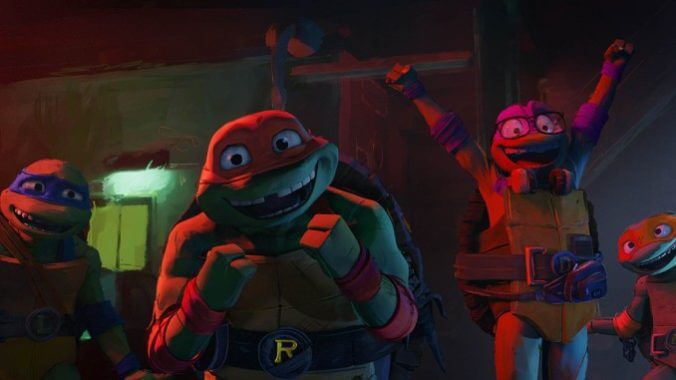
A visual tour de force of hybrid 2D and 3D animation, Mutant Mayhem is not only the most authentically New York version of the Turtles yet, it’s arguably the most inventive. Rowe, Spears and production designer Yashar Kassai have rendered the brothers as if they’re hand-drawn, complete with messy sketch lines, doodle flairs and a graffiti aesthetic. This is the ultimate paint-outside-the-lines take on the Turtles and it works on every level. Teenage Mutant Ninja Turtles: Mutant Mayhem is swinging for the fences with its story and voice performances to ambitiously, quantifiably shake up the artistic rut that theatrical computer animation has been stuck in for the last two decades. Another plus is that the brothers are voiced by non-adult voice actors Nicolas Cantu (Leo), Brady Noon (Raph), Shamon Brown Jr. (Mikey) and Micah Abbey (Donnie), who recorded together, and were encouraged to excitedly talk over one another like a gaggle of real, tight-knit brothers would do. It translates into rapid-fire, organic quips and seemingly effortless timing that conveys a rapport that is singular to this iteration. It also elevates the script so that it doesn’t sound like it was written by a bunch of 40-year-olds trying to be hip and young. Rowe and Spears have a firm hold on their pacing, especially in how they use comedy to enhance their action beats. They also chart a progression to the brother’s battle prowess that is satisfying and pays off in satisfying full-circle moments. There’s also much to be admired in their choice to frame a lot of sequences with hand-held camera blocking, which leans into the unpredictable youth of the heroes that works so well in the gritty New York environs they’re sparring in. The filmmakers are also delightfully experimental throughout the Mutant Mayhem, using inspired live-action inserts, segueing into different artistic styles (including a homage to Eastman and Laird’s comic art) and embracing the asymmetrical character design that gives the film a fresh and energetic looseness. Rowe and company prove that there’s no strength to the myth of IP fatigue when you have the vision and passion to reinvent with such bold and fun intention.—Tara Bennett
11. Smoking Causes Coughing
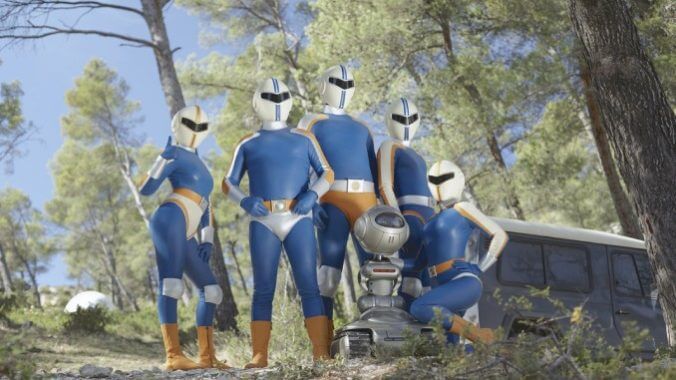
After half a decade focusing on high-concept silliness, like the giant-fly tragicomedy Mandibles and the leather-jacket thriller Deerskin, Dupieux follows his more ridiculous impulses by letting the midnight horror anthology stay up until Saturday morning, blending gore and guffaws in an amiable, breezy comedy. The Tobacco Force, a supergroup of “avengers” empowered by carcinogens, composes the film’s framing ensemble. A Power Rangers-like tokusatsu parody, they are like Dupieux’s Danger 5—a retro satire of form that revels in how desperately adult so much of its juvenile source material is. Where Danger 5 made running gags of the sexism and repetitive plotting of the spy/adventure serial, Smoking Causes Coughing utilizes eye-popping colors and frequent splashes of blood for its heroic team. But Smoking Causes Coughing avoids repeating The Boys or The Suicide Squad’s self-aware jabs at skin-tight costuming, empowered immaturity or mad villain plots by avoiding awareness altogether. Instead, it leans into the low-fi pulp aesthetic of cheapy TV and the bumbling clownishness particular to Dupieux’s brand of comic incompetence. Harmless stupidity is where Dupieux thrives. Smoking Causes Coughing plays to these strengths, being both sublimely silly and unpredictably, addictively light. The comedy flows into and out of its nested stories without a care in the world, feeling like a loose showcase for all the goofy, horror-adjacent ideas Dupieux had over the pandemic. Because the superheroes spinning these tales are themselves odd, stunted cartoons, their horrific fables are decidedly more absurd than anything else; think Drunk History but for turning the ramblings of a little kid into bloody short films. One centers on a thought-enhancing helmet that drives its wearer to, logically, attack her doofus friends. Another, told by an inexplicably talking barracuda, involves the best wood chipper joke since Fargo. The common thread linking these tales from the dorkside is slangish, intentionally undercooked dialogue that emphasizes the discord between the gruesome content and childish delivery. Naturally, Smoking Causes Coughing is too laid back to be much more than a feature-length smoke break from the heavier nonsense on the factory floor. But for those with a surreal sense of humor, hang up the “gone to lunch” sign and enjoy your union-mandated, 80-minute dose of French comedy.—Jacob Oller
-

-

-

-

-

-

-

-

-

-

-

-

-

-

-

-

-

-

-

-

-

-

-

-

-

-

-

-

-

-

-

-

-

-

-

-

-

-

-

-


